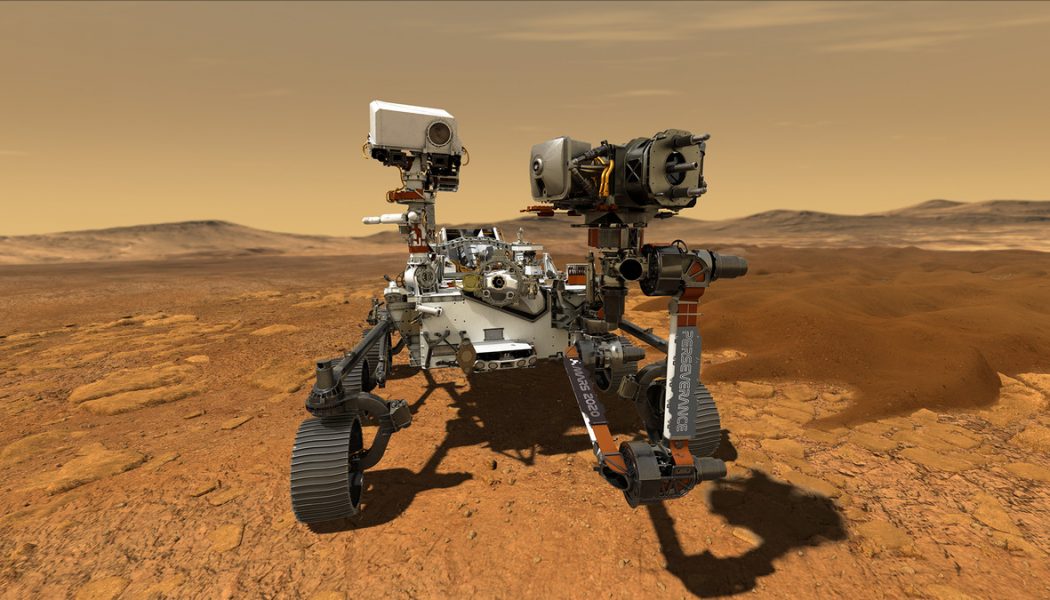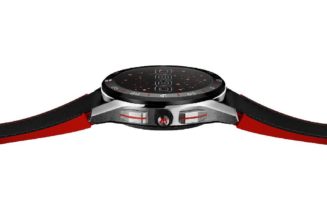NASA’s latest Mars rover — a six-wheeled SUV-sized robot named Perseverance — successfully launched from Florida this morning, embarking on a nearly seven-month journey to the Red Planet. Once it reaches Mars, it will attempt a harrowing landing to the surface and start exploring the planet’s terrain, hoping to solve the biggest lingering mysteries about Mars’ past.
The primary focus of Perseverance’s mission is to find out if Mars ever hosted life some 3.8 billion years ago. The rover is equipped with multiple instruments to search for signs of ancient microbes that may be lurking in the rocks and dirt on Mars. But most important of all, Perseverance is decked out with a sophisticated drilling system, designed to dig up samples of the planet’s surface, package them, and leave them in strategic deposits on Mars.
It’s just the first step in a very long, complicated process known as Mars sample return — the concept of bringing Martian rocks to Earth so that scientists can analyze them with all of the super-sensitive technologies we have in our laboratories. Perseverance is capable of collecting samples on Mars, but it’s not capable of bringing those samples to Earth. A follow-up mission will have to send another rover and a rocket to Mars to collect the samples and blast off from the surface.
Any follow-up missions could be up to a decade away, though. For now, the team behind the Perseverance mission is simply focused on getting the rover to Mars. Perseverance successfully launched from Cape Canaveral, Florida, at 7:50AM ET, and it separated from the vehicle about an hour later. NASA then acquired a signal from the rover, establishing a line of communication with the spacecraft that will continue all the way to Mars. Wrapped up inside a heat shield and an aeroshell, the rover will travel through interplanetary space over the coming months, reaching Mars sometime in February 2021.
“We’re on our way to Mars,” Omar Baez, NASA’s senior launch director at Kennedy Space Center said after the flight. “There’s no way back.”
:no_upscale()/cdn.vox-cdn.com/uploads/chorus_asset/file/20790583/1_PIA23764_RoverNamePlateonMars.png)
At that point, it’ll be time for Perseverance to make the plunge down to the surface of Mars. It’s going to be a nail-biting landing process similar to that of NASA’s Curiosity rover in 2012, a descent that the agency infamously nicknamed the “seven minutes of terror.” Perseverance will have just a few moments to perform a complex series of steps to slow itself down from 12,000 miles per hour to just 1.7 miles per hour so that it can land in one piece.
The rover will hide behind a heat shield to keep itself relatively cool as it descends through the Martian atmosphere. Eventually, the spacecraft will deploy a parachute to slow down even further. Once closer to the surface, a vehicle attached to Perseverance will ignite its thrusters, hovering in the air. That vehicle will then gently lower Perseverance down to the ground — in what’s known as a “sky crane” maneuver.
The good news is NASA successfully pulled this off once before with Curiosity, so hopefully the agency can get it right a second time. Plus, Perseverance is sporting some extra gadgets that should help ensure success. The rover is flying with a new “hazard avoidance system,” which will help the spacecraft avoid any troublesome rocks when it’s coming down to the ground. Perseverance’s destination is a place called Jezero Crater — a place that’s pretty tantalizing in the search for life but is also filled with lots of rock formations. To help Perseverance out, NASA created a hazard map of Jezero Crater, using images taken from spacecraft in orbit around Mars, and uploaded it to the rover.
During landing, Perseverance will try to spot the hazards by itself. “As we’re coming down, getting close to the planet, we take a picture,” Matthew Wallace, deputy program manager for the Perseverance mission at NASA, said during a pre-launch press conference, said. “We find ourselves in the hazard map that we’ve gotten on board, and then we divert away from the most significant hazards to the spacecraft. And so it does significantly improve our probability of landing and in a safe way.”
:no_upscale()/cdn.vox-cdn.com/uploads/chorus_asset/file/20790585/Mars_Perseverance_Trajectory_original.png)
Perseverance also has some extra goodies that could make this landing fun for everyone. The rover is carrying microphones, so it will record all of the sounds of the landing sequence. Perseverance is also decked out with lots of high-resolution cameras, so we may even get to see what it looks like to land on Mars from the rover’s point of view. “They’ll get high definition video that we’ll bring back after we land on the surface of the entire landing activity — from the inflation of the parachute to the touchdown of the rover,” Wallace said. “And that’s going to be some very exciting footage.”
Once the rover lands, it will be powered by a nearly 11-pound package of radioactive plutonium, or plutonium-238. As the plutonium decays over time, it generates heat, which is then converted into electricity. For decades, plutonium-238 was running low in supply, as the US stopped producing the material more than 30 years ago. But in 2015, the Department of Energy successfully restarted production and the stockpile started growing again. The Oak Ridge National Laboratory created the plutonium that will power Perseverance, the first time plutonium-238 created by the lab will power a NASA mission.
The rover is also famously carrying a tiny helicopter in its belly, which could become the first human-made vehicle to take flight on another world. Five pieces of NASA’s future space suits are also hitching a ride to test out their durability on Mars. Engineers also packed fragments of a known Martian meteorite into the rover, sending a small piece of Mars back home. And three microchips filled with nearly 11,000,000 names are on their way to Mars, too, part of NASA’s “Send Your Name to Mars” campaign.
Now comes the long wait as Perseverance and its brood journey through deep space. When the rover arrives, it may have a lot of company. Two other Mars missions are scheduled to arrive at the Red Planet in February: the United Arab Emirates’ weather satellite, called Hope, as well as China’s Tianwen-1 mission, which also includes a rover. That means all eyes will be on Mars again early next year.










